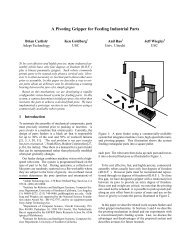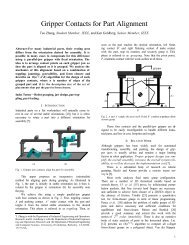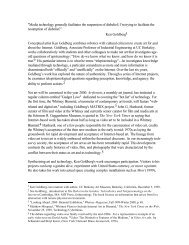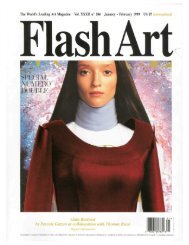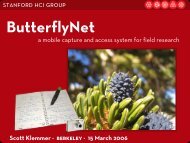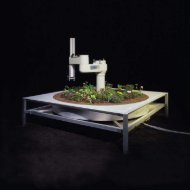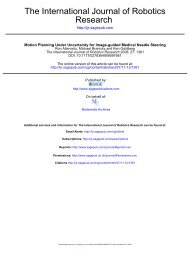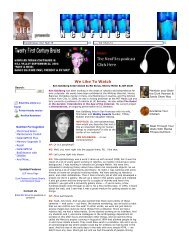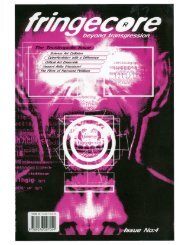“Are We There Yet?” Visual Tracking of Visitors ... - Ken Goldberg
“Are We There Yet?” Visual Tracking of Visitors ... - Ken Goldberg
“Are We There Yet?” Visual Tracking of Visitors ... - Ken Goldberg
You also want an ePaper? Increase the reach of your titles
YUMPU automatically turns print PDFs into web optimized ePapers that Google loves.
<strong>“Are</strong> <strong>We</strong> <strong>There</strong> <strong>Yet</strong>?<strong>”</strong> 5<br />
The operating features <strong>of</strong> our system are derived from the unique requirements<br />
<strong>of</strong> an interactive audio installation. False negatives, i.e. people the system<br />
has not detected, are particularly problematic because the visitors expect<br />
a response from the system and become frustrated or disillusioned when the<br />
response doesn’t come. Some tolerance is allowed for false positives, which add<br />
audio tracks to the installation; a few add texture and atmosphere. However,<br />
too many false positives creates cacophony. Performance <strong>of</strong> vision segmentation<br />
algorithms is <strong>of</strong>ten presented in terms <strong>of</strong> precision and recall [30]; many false<br />
negatives corresponds to a system with low recall. Many false positives lowers<br />
precision. <strong>We</strong> discuss precision, recall, and the F2-score in Section 1.7.<br />
Section 4 contains an experimental evaluation <strong>of</strong> the algorithm on video collected<br />
during the 4 months the system operated in the gallery. <strong>We</strong> evaluate<br />
performance with recall and the F2-score [16],[24]. Our results on three distinct<br />
tracking scenarios indicate a significant performance gain over the algorithms in<br />
OpenCV 2.1, when used with the recommended parameters. Further, we demonstrate<br />
that the feedback loop between the segmentation and tracking subsystems<br />
improves performance by further increasing recall and the F2-score.<br />
Fig. 2. Participant Experience: “Entering the Yud Gallery, you encounter soaring walls<br />
and windows carving the space with sunlight. A voice asks: “Can we talk?<strong>”</strong> A pause.<br />
<strong>“Are</strong> you Jewish?<strong>”</strong> You discover that the space is speaking to you. <strong>“Are</strong> you experienced?<strong>”</strong><br />
As you move, the questions become more abstract, “Who is a Jew?<strong>”</strong>, “Is<br />
patience a virtue?<strong>”</strong>, “Is truth a matter <strong>of</strong> perspective?<strong>”</strong> You realize you are creating<br />
your own experience. Questions take on new contexts and meanings as you explore and<br />
consider questions that resonate in new ways.<strong>”</strong> - From the installation description. See<br />
are-we-there-yet.org for more.


